sensor TOYOTA VERSO 2011 Owner's Manual
[x] Cancel search | Manufacturer: TOYOTA, Model Year: 2011, Model line: VERSO, Model: TOYOTA VERSO 2011Pages: 588, PDF Size: 31.32 MB
Page 248 of 588
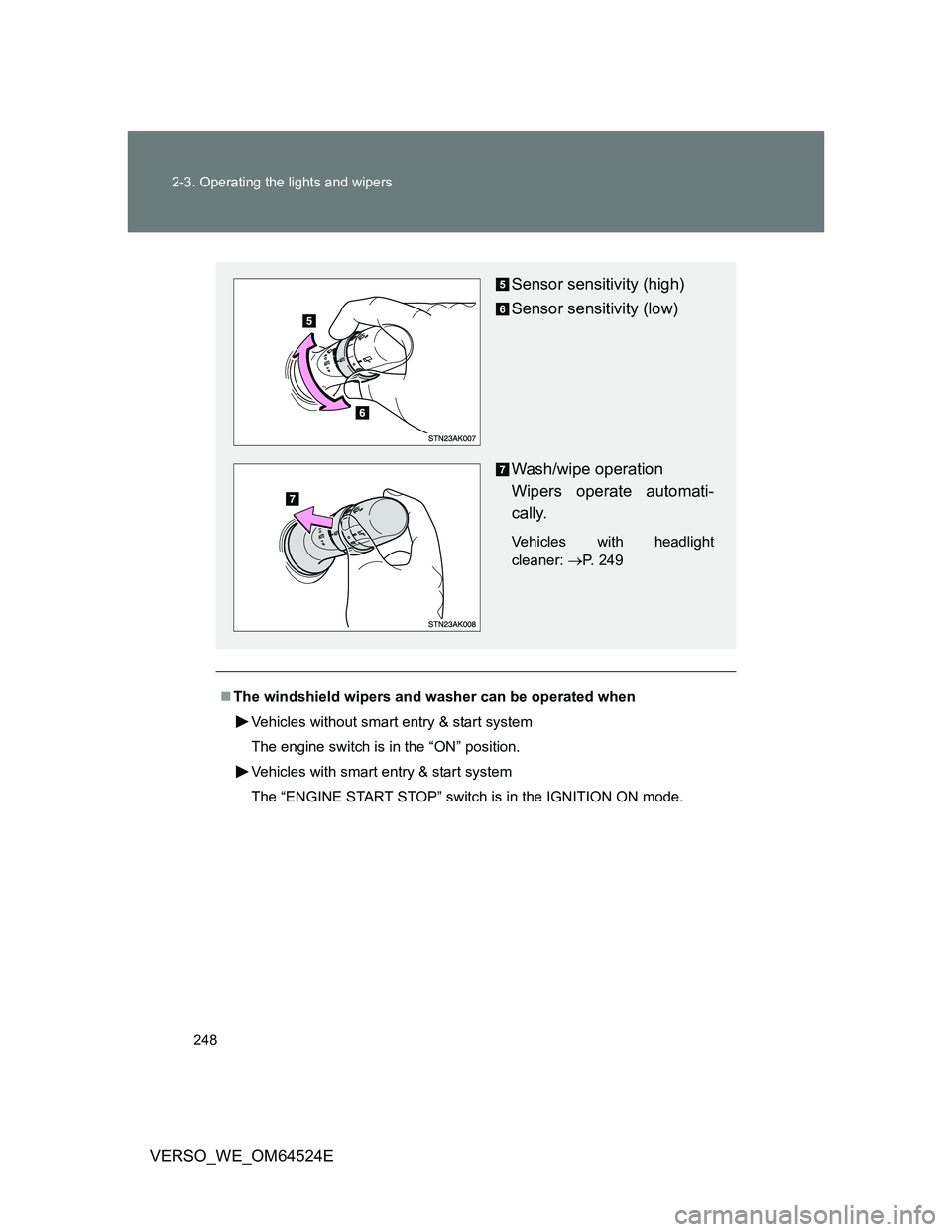
248 2-3. Operating the lights and wipers
VERSO_WE_OM64524E
The windshield wipers and washer can be operated when
Vehicles without smart entry & start system
The engine switch is in the “ON” position.
Vehicles with smart entry & start system
The “ENGINE START STOP” switch is in the IGNITION ON mode.
Sensor sensitivity (high)
Sensor sensitivity (low)
Wash/wipe operation
Wipers operate automati-
cally.
Vehicles with headlight
cleaner: P. 249
Page 249 of 588
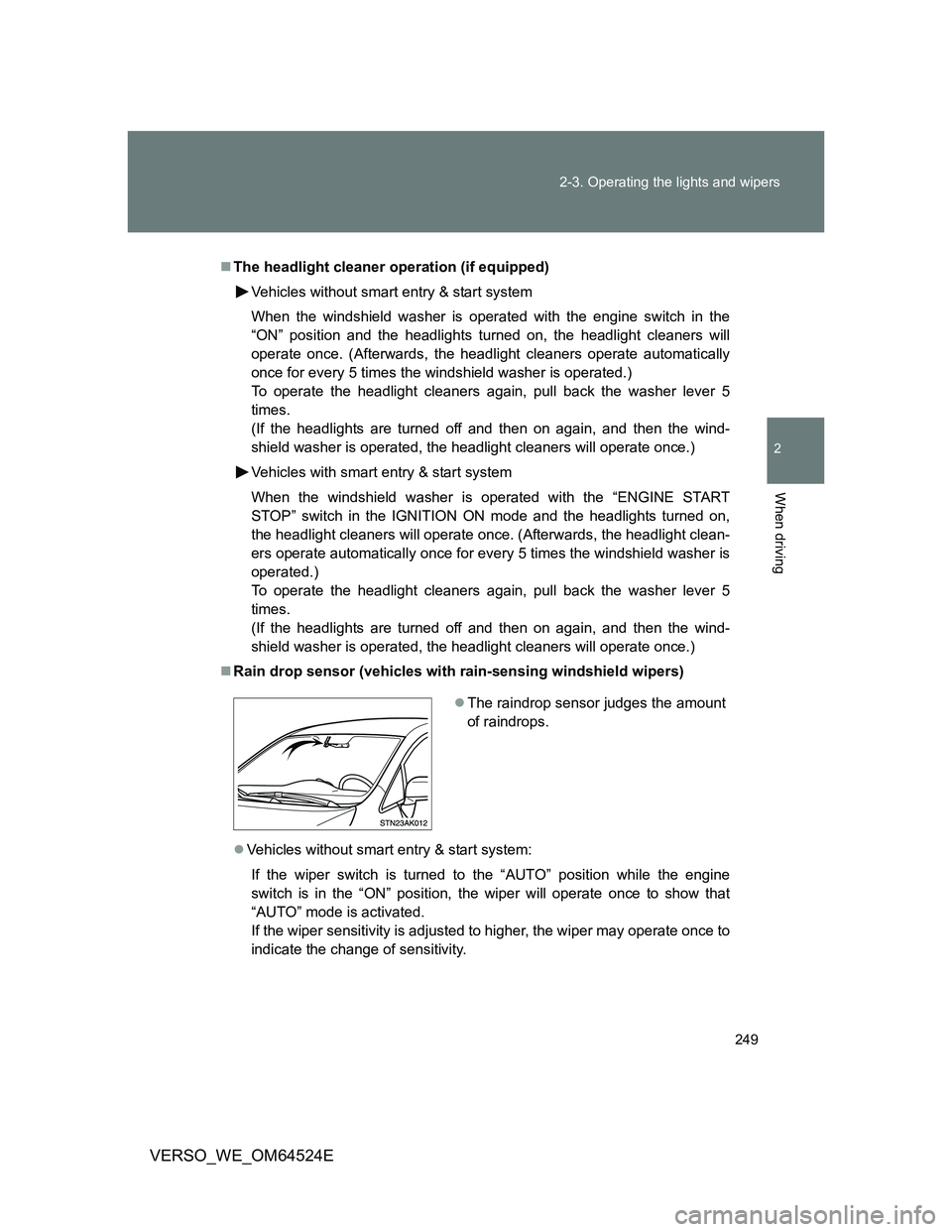
249 2-3. Operating the lights and wipers
2
When driving
VERSO_WE_OM64524E
The headlight cleaner operation (if equipped)
Vehicles without smart entry & start system
When the windshield washer is operated with the engine switch in the
“ON” position and the headlights turned on, the headlight cleaners will
operate once. (Afterwards, the headlight cleaners operate automatically
once for every 5 times the windshield washer is operated.)
To operate the headlight cleaners again, pull back the washer lever 5
times.
(If the headlights are turned off and then on again, and then the wind-
shield washer is operated, the headlight cleaners will operate once.)
Vehicles with smart entry & start system
When the windshield washer is operated with the “ENGINE START
STOP” switch in the IGNITION ON mode and the headlights turned on,
the headlight cleaners will operate once. (Afterwards, the headlight clean-
ers operate automatically once for every 5 times the windshield washer is
operated.)
To operate the headlight cleaners again, pull back the washer lever 5
times.
(If the headlights are turned off and then on again, and then the wind-
shield washer is operated, the headlight cleaners will operate once.)
Rain drop sensor (vehicles with rain-sensing windshield wipers)
Vehicles without smart entry & start system:
If the wiper switch is turned to the “AUTO” position while the engine
switch is in the “ON” position, the wiper will operate once to show that
“AUTO” mode is activated.
If the wiper sensitivity is adjusted to higher, the wiper may operate once to
indicate the change of sensitivity.
The raindrop sensor judges the amount
of raindrops.
Page 250 of 588
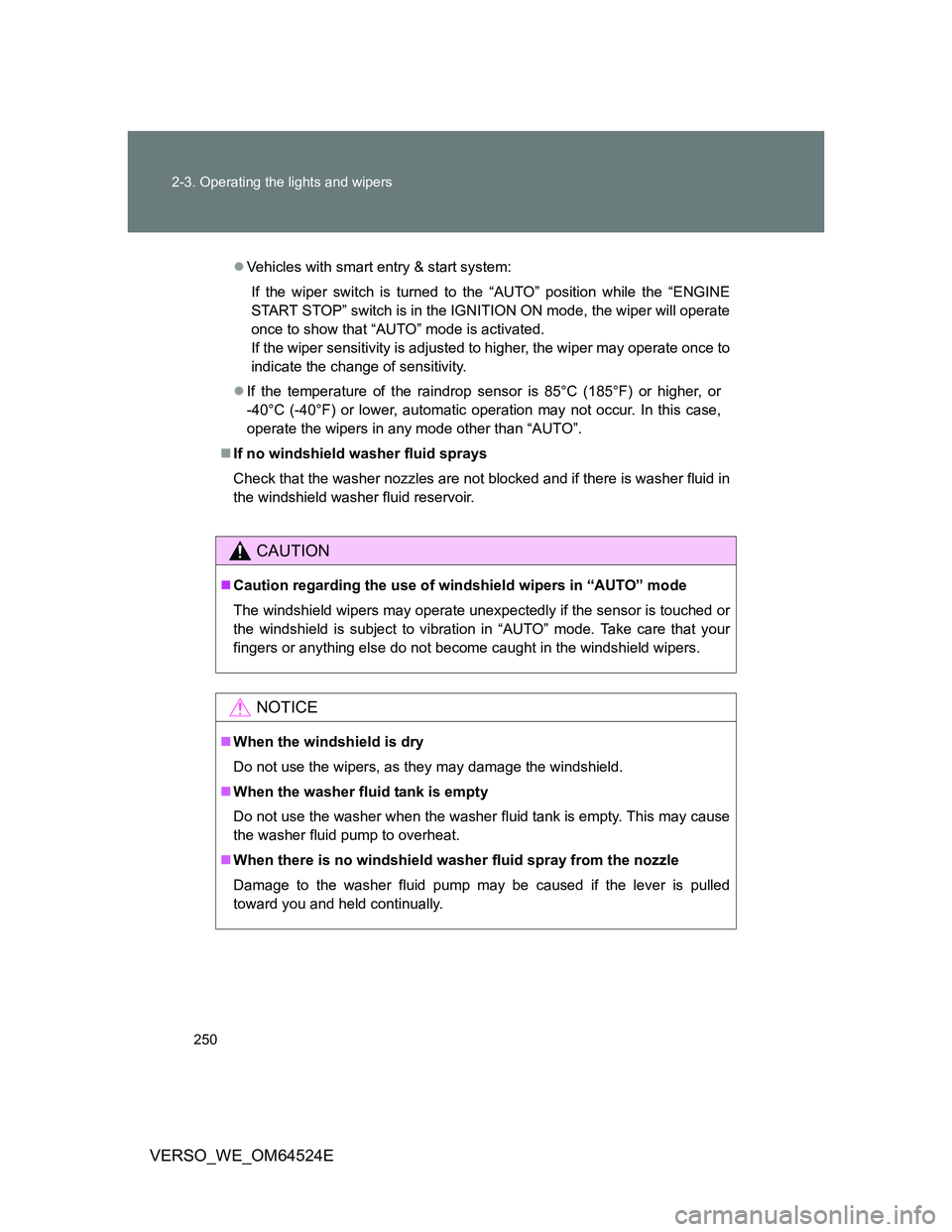
250 2-3. Operating the lights and wipers
VERSO_WE_OM64524E
Vehicles with smart entry & start system:
If the wiper switch is turned to the “AUTO” position while the “ENGINE
START STOP” switch is in the IGNITION ON mode, the wiper will operate
once to show that “AUTO” mode is activated.
If the wiper sensitivity is adjusted to higher, the wiper may operate once to
indicate the change of sensitivity.
If the temperature of the raindrop sensor is 85°C (185°F) or higher, or
-40°C (-40°F) or lower, automatic operation may not occur. In this case,
operate the wipers in any mode other than “AUTO”.
If no windshield washer fluid sprays
Check that the washer nozzles are not blocked and if there is washer fluid in
the windshield washer fluid reservoir.
CAUTION
Caution regarding the use of windshield wipers in “AUTO” mode
The windshield wipers may operate unexpectedly if the sensor is touched or
the windshield is subject to vibration in “AUTO” mode. Take care that your
fingers or anything else do not become caught in the windshield wipers.
NOTICE
When the windshield is dry
Do not use the wipers, as they may damage the windshield.
When the washer fluid tank is empty
Do not use the washer when the washer fluid tank is empty. This may cause
the washer fluid pump to overheat.
When there is no windshield washer fluid spray from the nozzle
Damage to the washer fluid pump may be caused if the lever is pulled
toward you and held continually.
Page 259 of 588
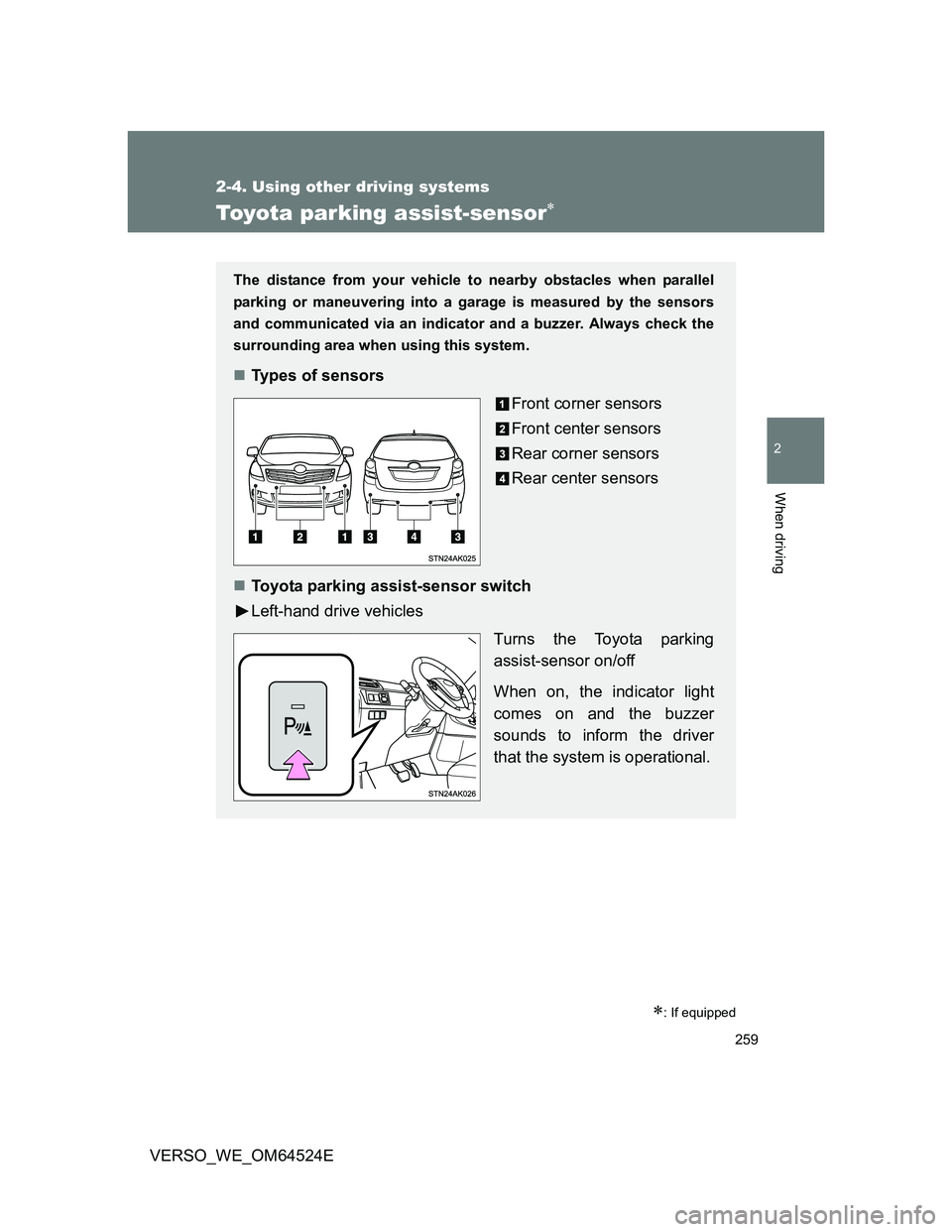
259
2-4. Using other driving systems
2
When driving
VERSO_WE_OM64524E
Toyota parking assist-sensor
: If equipped
The distance from your vehicle to nearby obstacles when parallel
parking or maneuvering into a garage is measured by the sensors
and communicated via an indicator and a buzzer. Always check the
surrounding area when using this system.
Types of sensors
Front corner sensors
Front center sensors
Rear corner sensors
Rear center sensors
Toyota parking assist-sensor switch
Left-hand drive vehicles
Turns the Toyota parking
assist-sensor on/off
When on, the indicator light
comes on and the buzzer
sounds to inform the driver
that the system is operational.
Page 260 of 588
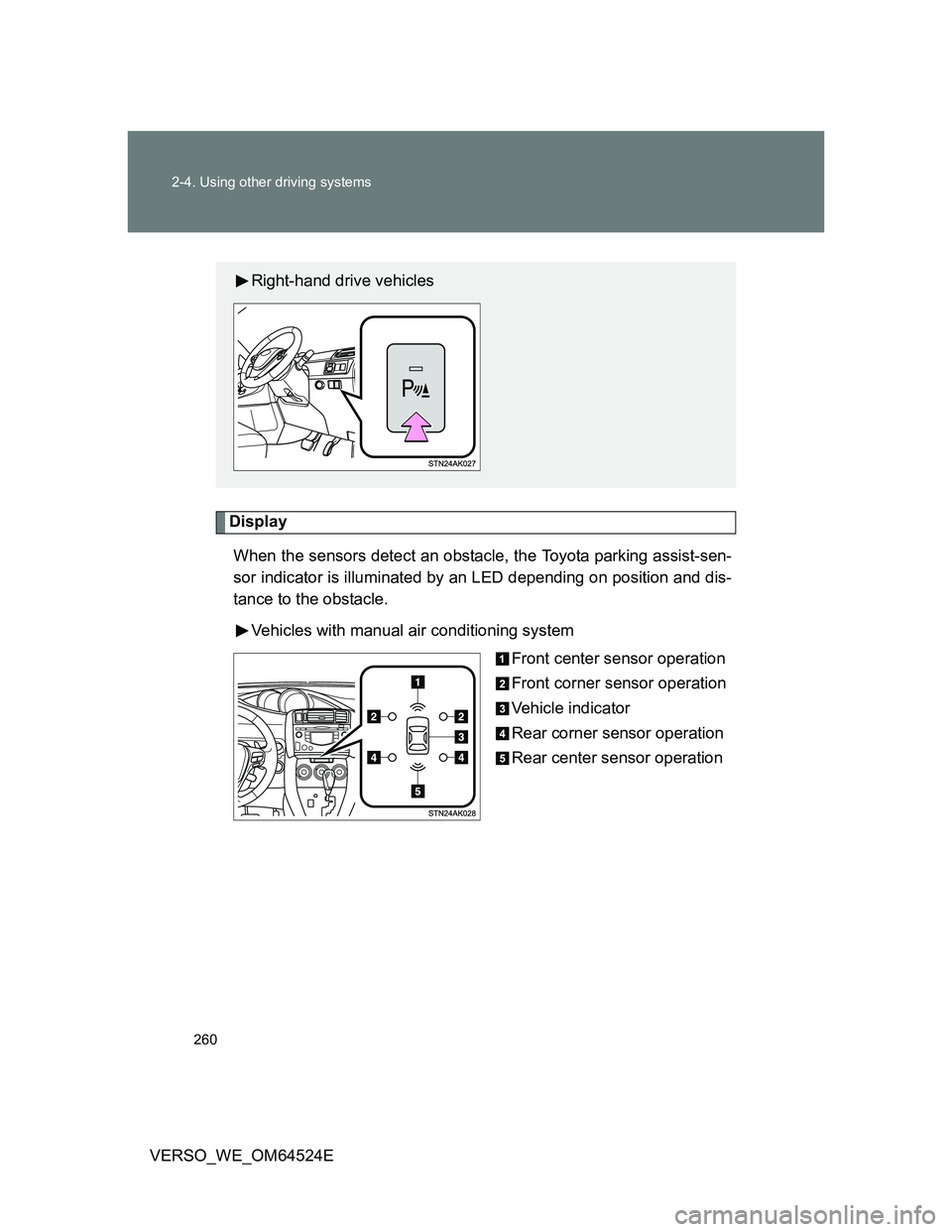
260 2-4. Using other driving systems
VERSO_WE_OM64524E
Display
When the sensors detect an obstacle, the Toyota parking assist-sen-
sor indicator is illuminated by an LED depending on position and dis-
tance to the obstacle.
Vehicles with manual air conditioning system
Front center sensor operation
Front corner sensor operation
Vehicle indicator
Rear corner sensor operation
Rear center sensor operation
Right-hand drive vehicles
Page 261 of 588
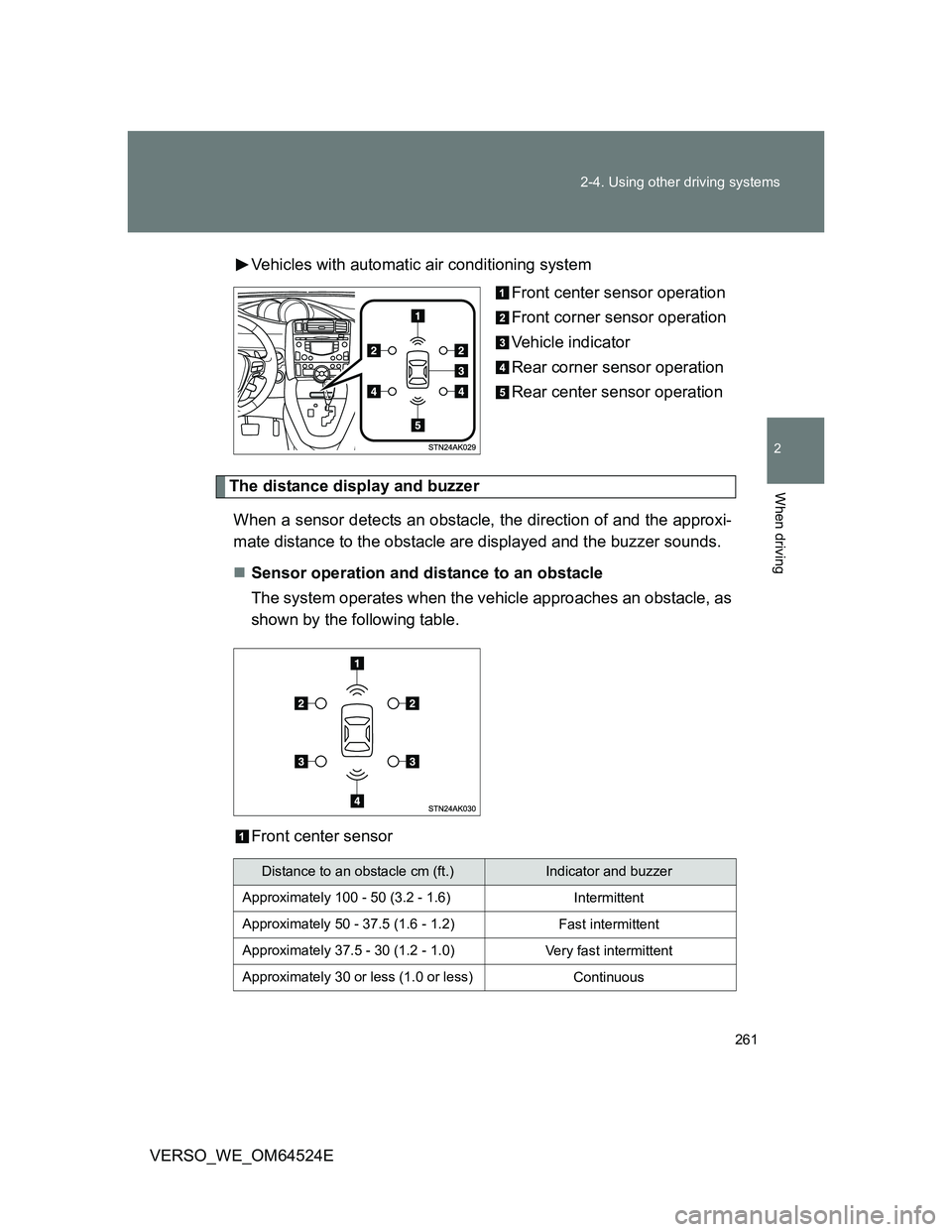
261 2-4. Using other driving systems
2
When driving
VERSO_WE_OM64524EVehicles with automatic air conditioning system
Front center sensor operation
Front corner sensor operation
Vehicle indicator
Rear corner sensor operation
Rear center sensor operation
The distance display and buzzer
When a sensor detects an obstacle, the direction of and the approxi-
mate distance to the obstacle are displayed and the buzzer sounds.
Sensor operation and distance to an obstacle
The system operates when the vehicle approaches an obstacle, as
shown by the following table.
Front center sensor
Distance to an obstacle cm (ft.)Indicator and buzzer
Approximately 100 - 50 (3.2 - 1.6)
Intermittent
Approximately 50 - 37.5 (1.6 - 1.2)
Fast intermittent
Approximately 37.5 - 30 (1.2 - 1.0)
Very fast intermittent
Approximately 30 or less (1.0 or less)
Continuous
Page 262 of 588
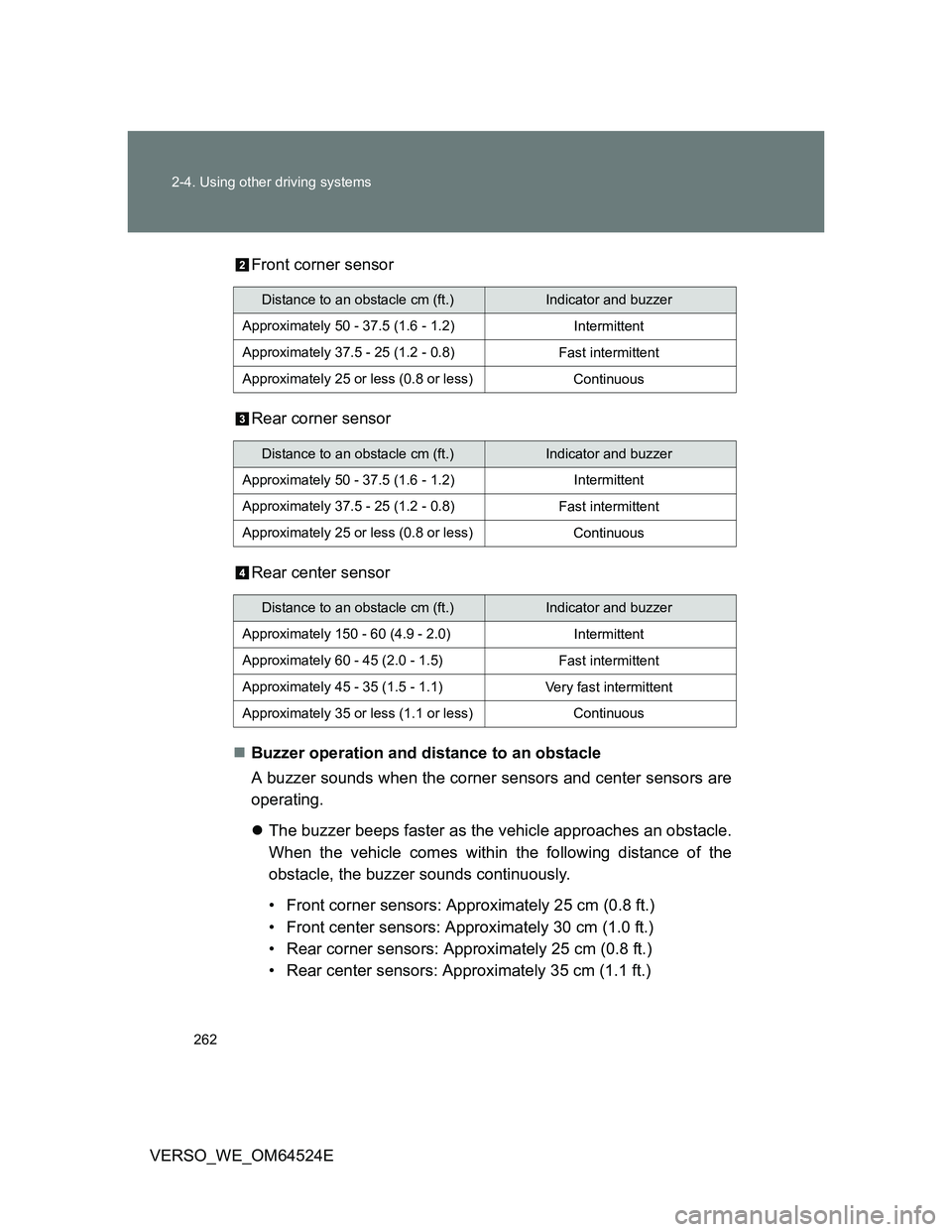
262 2-4. Using other driving systems
VERSO_WE_OM64524EFront corner sensor
Rear corner sensor
Rear center sensor
Buzzer operation and distance to an obstacle
A buzzer sounds when the corner sensors and center sensors are
operating.
The buzzer beeps faster as the vehicle approaches an obstacle.
When the vehicle comes within the following distance of the
obstacle, the buzzer sounds continuously.
• Front corner sensors: Approximately 25 cm (0.8 ft.)
• Front center sensors: Approximately 30 cm (1.0 ft.)
• Rear corner sensors: Approximately 25 cm (0.8 ft.)
• Rear center sensors: Approximately 35 cm (1.1 ft.)
Distance to an obstacle cm (ft.)Indicator and buzzer
Approximately 50 - 37.5 (1.6 - 1.2)
Intermittent
Approximately 37.5 - 25 (1.2 - 0.8)
Fast intermittent
Approximately 25 or less (0.8 or less)
Continuous
Distance to an obstacle cm (ft.)Indicator and buzzer
Approximately 50 - 37.5 (1.6 - 1.2)
Intermittent
Approximately 37.5 - 25 (1.2 - 0.8)
Fast intermittent
Approximately 25 or less (0.8 or less)
Continuous
Distance to an obstacle cm (ft.)Indicator and buzzer
Approximately 150 - 60 (4.9 - 2.0)
Intermittent
Approximately 60 - 45 (2.0 - 1.5)
Fast intermittent
Approximately 45 - 35 (1.5 - 1.1)
Very fast intermittent
Approximately 35 or less (1.1 or less)
Continuous
Page 263 of 588
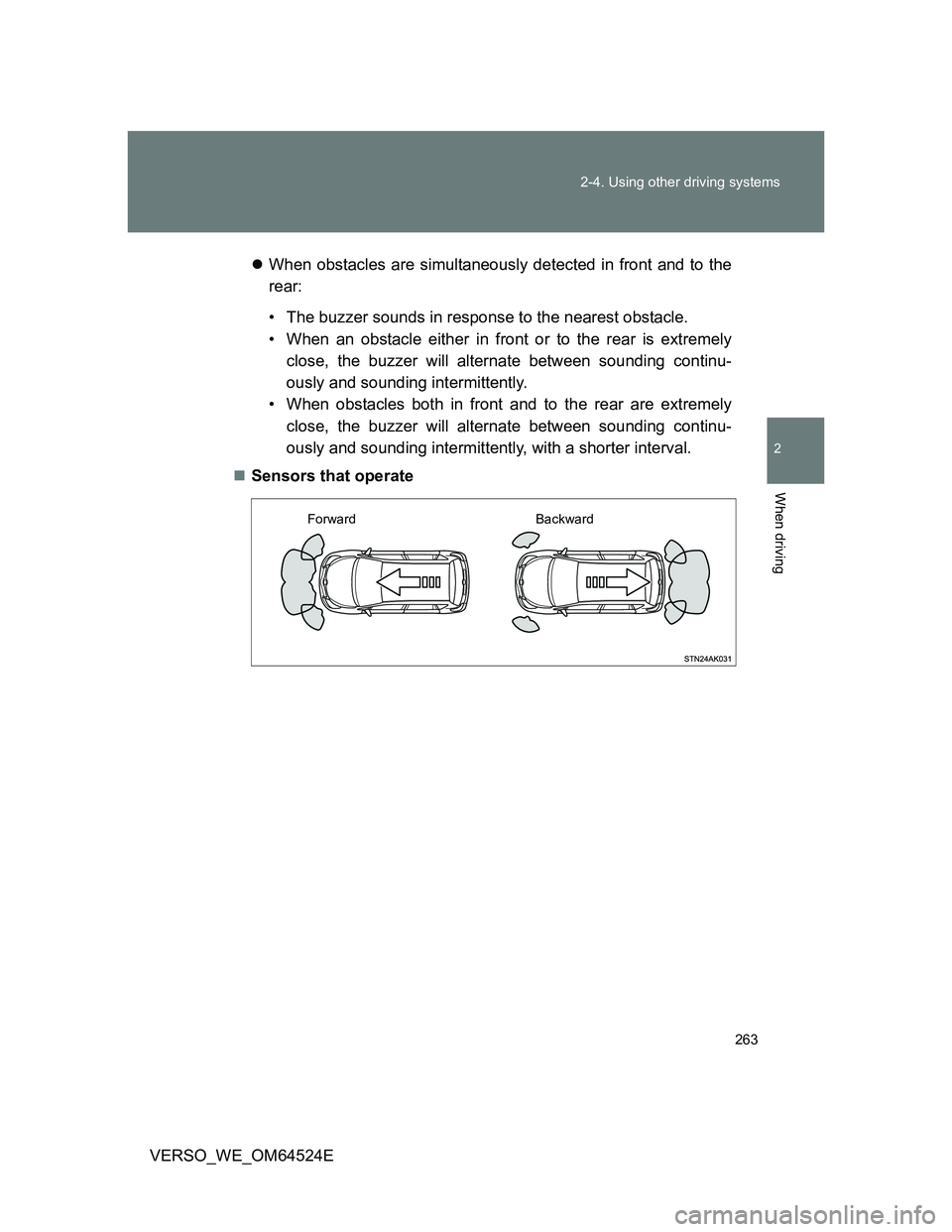
263 2-4. Using other driving systems
2
When driving
VERSO_WE_OM64524EWhen obstacles are simultaneously detected in front and to the
rear:
• The buzzer sounds in response to the nearest obstacle.
• When an obstacle either in front or to the rear is extremely
close, the buzzer will alternate between sounding continu-
ously and sounding intermittently.
• When obstacles both in front and to the rear are extremely
close, the buzzer will alternate between sounding continu-
ously and sounding intermittently, with a shorter interval.
Sensors that operate
Forward Backward
Page 264 of 588
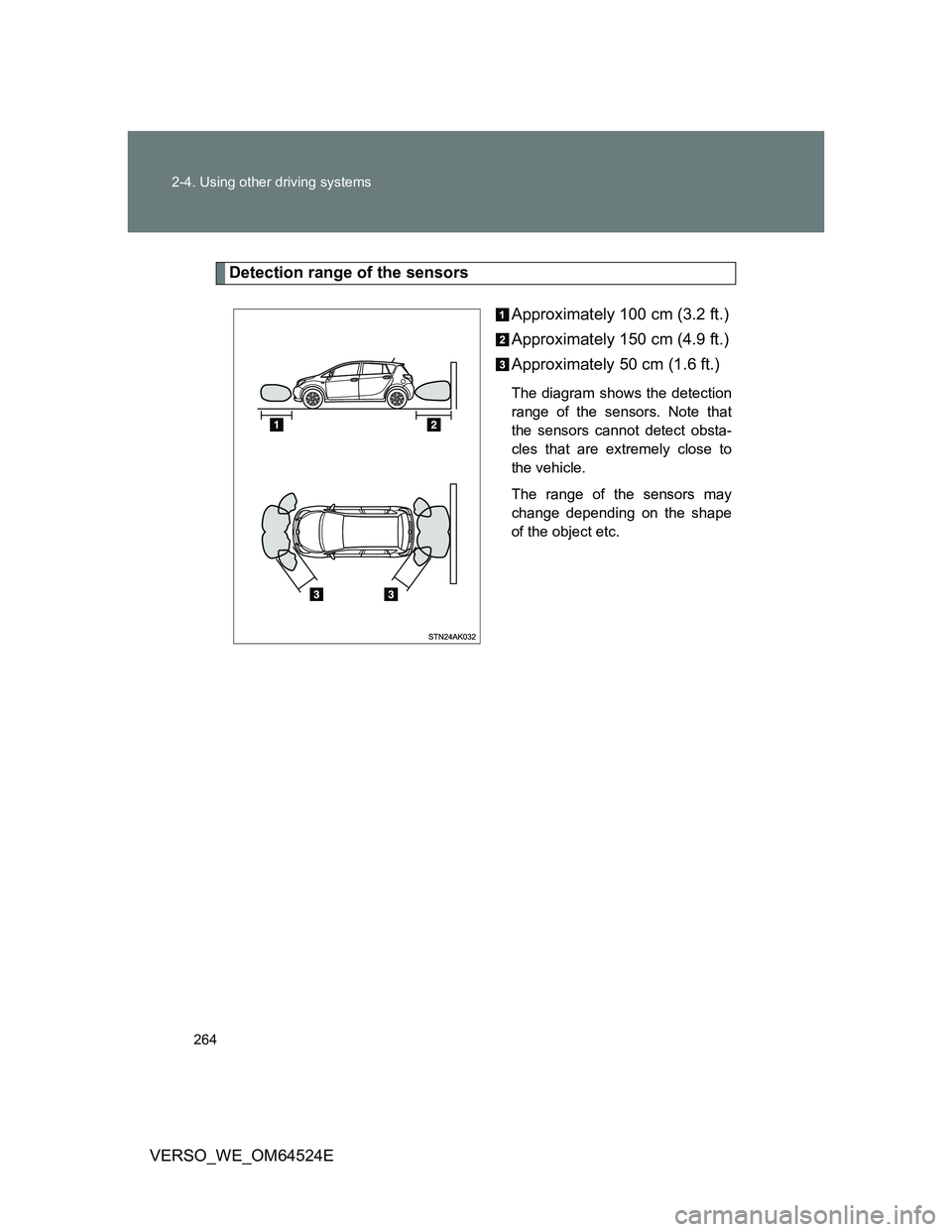
264 2-4. Using other driving systems
VERSO_WE_OM64524E
Detection range of the sensors
Approximately 100 cm (3.2 ft.)
Approximately 150 cm (4.9 ft.)
Approximately 50 cm (1.6 ft.)
The diagram shows the detection
range of the sensors. Note that
the sensors cannot detect obsta-
cles that are extremely close to
the vehicle.
The range of the sensors may
change depending on the shape
of the object etc.
Page 265 of 588
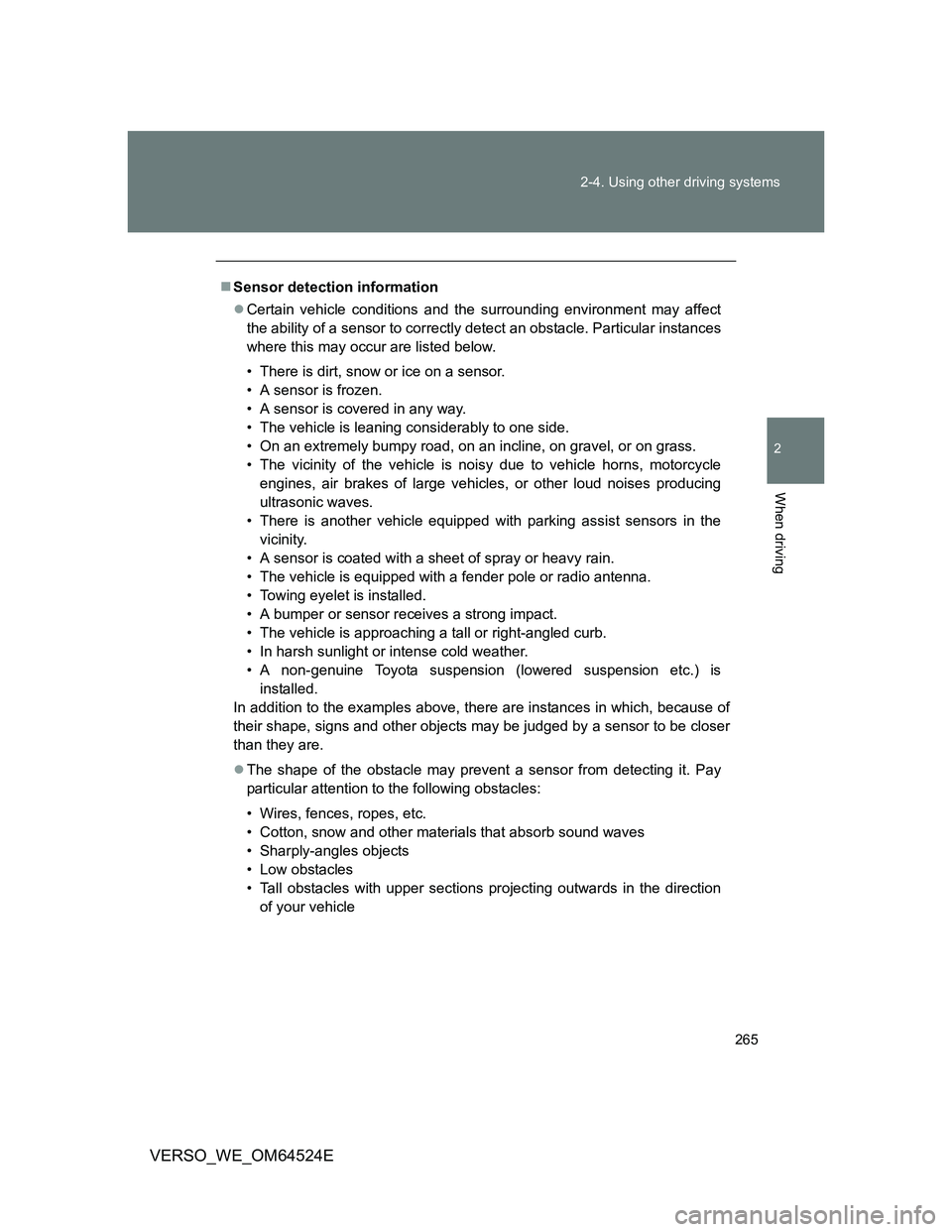
265 2-4. Using other driving systems
2
When driving
VERSO_WE_OM64524E
Sensor detection information
Certain vehicle conditions and the surrounding environment may affect
the ability of a sensor to correctly detect an obstacle. Particular instances
where this may occur are listed below.
• There is dirt, snow or ice on a sensor.
• A sensor is frozen.
• A sensor is covered in any way.
• The vehicle is leaning considerably to one side.
• On an extremely bumpy road, on an incline, on gravel, or on grass.
• The vicinity of the vehicle is noisy due to vehicle horns, motorcycle
engines, air brakes of large vehicles, or other loud noises producing
ultrasonic waves.
• There is another vehicle equipped with parking assist sensors in the
vicinity.
• A sensor is coated with a sheet of spray or heavy rain.
• The vehicle is equipped with a fender pole or radio antenna.
• Towing eyelet is installed.
• A bumper or sensor receives a strong impact.
• The vehicle is approaching a tall or right-angled curb.
• In harsh sunlight or intense cold weather.
• A non-genuine Toyota suspension (lowered suspension etc.) is
installed.
In addition to the examples above, there are instances in which, because of
their shape, signs and other objects may be judged by a sensor to be closer
than they are.
The shape of the obstacle may prevent a sensor from detecting it. Pay
particular attention to the following obstacles:
• Wires, fences, ropes, etc.
• Cotton, snow and other materials that absorb sound waves
• Sharply-angles objects
• Low obstacles
• Tall obstacles with upper sections projecting outwards in the direction
of your vehicle